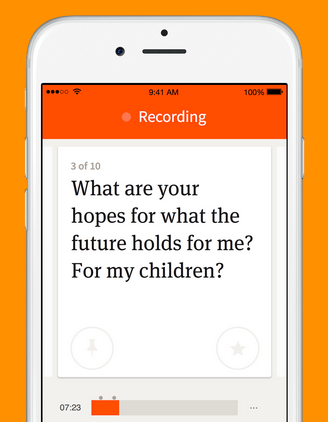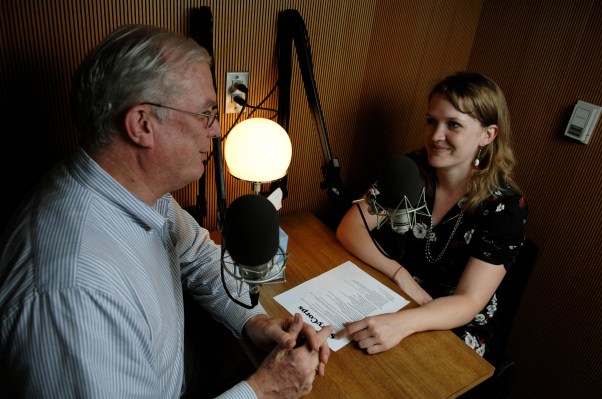Each day, we talk to lots of people: meetings with coworkers, dinnertime chats with family or friends, messages on social media. When was the last time, however, you had a long conversation with someone about the things that really matter to both of you?
Since 2003, Brooklyn-based non-profit organization StoryCorps has encouraged people to ask each other meaningful questions. As an oral history project, it has been very successful–so far, StoryCorps has archived 65,000 interviews, which it claims is the largest single collection of human voices ever gathered. The recordings, conducted in StoryCorps’ booths across the U.S., are stored in American Folklife Center of the Library of Congress, with excerpts broadcast on NPR.
With the recent release of its first app for iOS and Android, StoryCorps has dramatically expanded its reach. The app is still in beta, but in just two weeks it has already gained 50,000 registered users from the world. Sometime today the app will pass 1,000 uploaded interviews—over 20 percent the number of recordings StoryCorps is able to do in its booths each year.
What Makes StoryCorps Special
I first encountered StoryCorps while volunteering with Girls Write Now, a mentoring organization in New York City. It was part of a roster of “getting to know you” activities I did with my mentee, a high schooler named Xiao. I had seen StoryCorps’ booths, filled with professional recording equipment, around the city and was excited to see the inside of one, but I was surprised by the experience.
For people who don’t think their stories matter, it shows how much they do.
It sounds cheesy, but the 40 minutes I spent in the booth talking to Xiao changed my life. The questions were thought-provoking but never intrusive, and I felt I learned as much about myself as I did about her. It’s been eight years, and I still have the MP3 stored on my computer and in Dropbox.
I left wanting to do a StoryCorps interview with everybody I care about, but I moved to Taiwan soon afterward. I have been waiting for StoryCorps to expand ever since and its app gives me chance to relive my experience, even though I am now an ocean away from the nearest booth.
Of course, I could have just sat people down with a list of questions and a digital recorder. I believe, however, that the StoryCorps app is a crucial part of the experience.

In a StoryCorps booth, an interview is conducted as a conversation between two participants who take turns asking each other questions. A trained staff member, however, helps things along. For example, if the conversation stalls, they will suggest new topics.
For people who don’t have access to a booth, the app takes the place of the StoryCorps staffer.
“It’s a human connection play. The app is a digital facilitator and as best as possible, we’re trying to approximate the experience with the app,” says StoryCorps founder Dave Isay.
Using the app is easy: you select questions from several lists which you can then scroll through during an interview. At the end of a recording, you can choose to upload it to StoryCorps’ archive or just save it to your smartphone. Recordings from other users can also be browsed and listened to through the app.
Discussions about the alienating effects of technology are so common now they’ve become a cliché. As a counterpoint, many developers are also exploring how tech can help close the chasms between people by creating empathy through virtual reality, live video, or even “Fitbits for feelings.”
The StoryCorps app is very simple, but it succeeds in melding technology and empathy by creating a context for a conversation and making it easier to bring up topics that might feel too awkward or sensitive to broach in a casual chat, even with someone you are close to. It is the ultimate icebreaker.
The Importance Of Memory-keeping
Another reason the app stands out is because it bucks ongoing trend for ephemerality exemplified by apps like Snapchat, which are especially popular among Millennials.
Among the new people who the StoryCorps app has reached are a large cohort of teenagers.
“A lot of college kids are doing these in their dorm rooms,” says Isay. “You can have a couple of jock guys and by the end of it, they are crying. I think everyone is searching for an authentic connection. Many times the kind of connections that happen on the Internet are not as authentic as one would want. To me, what StoryCorps is about is this permanence and authenticity in a time when so much is fleeting.”
One interesting phenomena is “audio selfies,” or people using the StoryCorps app on their own, which surprised Isay.
“I didn’t expect that. It’s not therapy, but if doing an interview with themselves makes people feel like they matter, it gives them a little bit of space to do that,” he says.
Ultimately, though, Isay’s goal for the app and StoryCorps is to help people connect with one another.
“For people who don’t think their stories matter, it shows how much they do.”
StoryCorps had previously considered developing an app, but it wasn’t possible until the organization recently received a $1 million TED prize. It worked with MAYA Design in Pittsburgh to develop the app’s beta version in two months for the competition.
It was released on March 17 with a TED talk by Isay.
“The last couple of weeks have felt like the launch for StoryCorps all over again,” he says. “Instead of thousands of interviews, we can do tens of thousands. Right now we do about five or six thousand a year in our booths and obviously we can reach many more people with the app.”
“Suddenly, as of two weeks ago, we were international. Within the first hour after it was released, after it was released, the first story came from outside the U.S.”
The organization plans to work with the TEDx program’s network of organizers and TED’s volunteer translator program to localize the app’s questions into different languages. As the app gains more users around the world, StoryCorps plans to find each country’s equivalent of the Library of Congress and create an archive for recordings there.
To achieve those goals, however, the StoryCorps app needs more funding. It has already spent the TED Prize on the app’s development, its companion website, and server space to store interviews.
StoryCorps must raise a minimum of $2.5 million over the next three years to keep the project running and Isay has been busy traveling the U.S. to look for foundations and non-profits that can contribute.
The potential benefits of the project and the archive of oral histories it will create, however, are priceless. With the app, StoryCorps can now reach places like homeless shelters, senior residences, refugee camps, and prisons, where interviews can be conducted with people whose experiences are often overlooked or discounted.
“My dream is to convince the Department of Education and other organizations to do a national homework assignment with every kid in a high school U.S. history class where they interview a grandparent or other elder, so an entire generation of stories can be honored and documented,” says Isay. “That’s the kind of thing that is possible with this and I’m psyched.”
